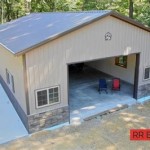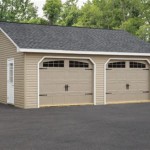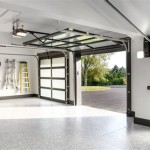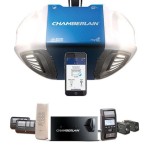Building a Home Gym in Your Garage: A Comprehensive Guide
Transforming a garage into a functional and effective home gym is a project that requires careful planning and execution. The benefits of having a personal workout space are numerous, from increased convenience and flexibility to potential cost savings in the long run. This article provides a detailed guide to designing and building a home gym in a garage, covering essential considerations like space planning, equipment selection, flooring, ventilation, and safety.
The initial step involves a thorough assessment of the garage space. This includes accurately measuring the dimensions of the garage to determine the available square footage. Consider the height of the ceiling, as this will impact the type of equipment that can be accommodated, especially pull-up bars and overhead pressing exercises. Note the location of existing electrical outlets and consider whether additional outlets are needed to support the planned equipment. Evaluate the existing lighting and determine if upgrades are necessary to provide adequate illumination for safe and effective workouts. Analyze the garage door operation and ensure that the door mechanism does not interfere with the proposed workout area.
Space planning is a critical aspect of designing a garage gym. Before purchasing any equipment, create a layout of the desired gym configuration. This can be achieved using floor plan software, graph paper, or even simple sketches. Consider the movement patterns associated with different exercises and ensure that there is ample space to perform them safely and comfortably. Delineate specific zones within the garage for different types of activities, such as a weightlifting area, a cardio zone, and a stretching or yoga space. Maximize the use of vertical space by utilizing shelving and wall-mounted storage solutions to keep equipment organized and off the floor. Consider the placement of mirrors to enhance visibility and improve exercise form.
Selecting the appropriate equipment is a crucial decision that depends on individual fitness goals and preferences. The available budget will also play a significant role in determining the type and quality of equipment that can be acquired. Essential equipment for a basic home gym might include a weight bench, dumbbells, resistance bands, and a pull-up bar. Individuals interested in more advanced training may consider investing in a power rack, barbell, weight plates, and a cable machine. Cardio equipment options range from treadmills and elliptical trainers to stationary bikes and rowing machines. Consider the noise level of each piece of equipment, especially when using cardio machines or dropping weights. Research different brands and models to compare features, prices, and user reviews before making a purchase.
Key Point 1: Optimizing Space Usage and Layout
Efficient space utilization is paramount in a garage gym. Given the often-limited area, strategic layout planning is necessary. Begin by identifying the primary activities that will take place in the gym. If weightlifting is the focus, allocate a dedicated area for a power rack or squat stand. If cardio is a priority, determine the optimal placement for a treadmill or stationary bike. Consider the flow of movement between different exercise stations to avoid congestion and potential safety hazards.
Wall-mounted storage solutions are invaluable for maximizing space. Install shelves to hold dumbbells, kettlebells, and resistance bands. Utilize wall-mounted racks to store barbells and weight plates. Consider a foldable weight bench or squat rack that can be easily stored when not in use. Implement a pegboard system to hang smaller items like jump ropes, resistance bands, and foam rollers. Utilize the vertical space by installing a pull-up bar above a doorway or in a corner of the garage. Ensure that all storage solutions are securely mounted and can safely support the weight of the equipment being stored.
Mirrors are not only beneficial for monitoring exercise form but also create the illusion of a larger space. Strategically placing mirrors on one or more walls can significantly enhance the perceived size of the garage gym. Choose large, shatter-resistant mirrors for safety. Consider the lighting in relation to the mirrors to avoid glare and ensure clear visibility. Mirrors can also be used to define different exercise zones within the garage.
Key Point 2: Selecting Appropriate Flooring and Ventilation
Flooring is an essential component of a garage gym, providing both safety and comfort. The existing concrete floor in most garages is typically not suitable for exercise, as it is hard, unforgiving, and can be slippery. Common flooring options for a garage gym include rubber mats, interlocking foam tiles, and rolled rubber flooring.
Rubber mats are durable and shock-absorbent, making them ideal for weightlifting areas. They are available in various thicknesses and sizes to accommodate different needs. Interlocking foam tiles are a more affordable option, providing adequate cushioning for bodyweight exercises and light dumbbell work. Rolled rubber flooring offers a seamless and professional look, providing a uniform surface for a variety of activities. Ensure that the flooring is easy to clean and maintain. Consider the thickness of the flooring based on the type of exercises that will be performed. Thicker flooring is recommended for areas where heavy weights will be dropped.
Proper ventilation is crucial for maintaining a comfortable and safe workout environment, especially during strenuous exercise. Garages often lack adequate ventilation, leading to stuffiness, humidity, and potentially hazardous air quality. Consider installing an exhaust fan to remove stagnant air and improve air circulation. Ensure that the garage door can be opened to allow fresh air to enter the space. Portable air purifiers can help to remove dust, allergens, and other pollutants from the air. If the garage is insulated, ensure that the insulation does not impede airflow. Consider the climate and the frequency of workouts when determining the appropriate ventilation system.
Key Point 3: Prioritizing Safety and Essential Equipment
Safety should be the paramount consideration when building a home gym. Inspect all equipment regularly for signs of wear and tear. Ensure that all nuts and bolts are tightened properly. Replace any damaged equipment immediately. Learn proper lifting techniques to minimize the risk of injury. Consider consulting with a qualified personal trainer to learn proper form and technique, especially for complex exercises like squats, deadlifts, and overhead presses.
A well-stocked first-aid kit is an essential component of any home gym. Include bandages, antiseptic wipes, pain relievers, and any personal medications that are needed. Keep the first-aid kit readily accessible and ensure that everyone who uses the gym knows its location. Learn basic first-aid and CPR skills. Consider posting emergency contact information near the first-aid kit.
Investing in high-quality, essential equipment is crucial for building a functional and effective garage gym. A solid weight bench provides support for a variety of exercises, including chest presses, rows, and triceps extensions. A set of adjustable dumbbells allows for progressive overload and provides versatility for different muscle groups. Resistance bands are a cost-effective and portable option for adding resistance to various exercises. A pull-up bar is a fundamental piece of equipment for upper body strength training. Prioritize quality over quantity when selecting equipment. Invest in durable and reliable equipment that will withstand regular use. Consider purchasing used equipment to save money, but inspect it carefully for signs of damage or wear.
Electrical considerations are important to ensure the safe and efficient operation of the garage gym. Inspect the existing electrical outlets and determine if additional outlets are needed to support the equipment. Consider installing dedicated circuits for high-power equipment like treadmills and elliptical trainers. Ensure that all electrical work is performed by a qualified electrician. Use surge protectors to protect electronic equipment from power surges. Avoid overloading circuits, as this can create a fire hazard. Keep electrical cords away from water and moisture.
Lighting is a critical aspect of creating a safe and effective workout environment. Garages often have inadequate lighting, making it difficult to see clearly and potentially increasing the risk of injury. Consider installing additional lighting fixtures to brighten the space. LED lighting is an energy-efficient and long-lasting option. Position lighting fixtures to minimize shadows and glare. Consider installing task lighting in specific areas, such as over the weight bench or in the cardio zone. Natural light is also beneficial, so consider maximizing the amount of natural light that enters the garage through windows or skylights.

How To Turn Your Garage Into A Fitness Room

I Built My Dream Garage Home Gym

How To Create A Fitness Garage Gym In Your Home Schroeder Design Build

How To Turn Your Garage Into A Fitness Room

Home Gyms Build A Gym In Your Garage Motive8

Creating Your Own Home Gym

So You Want To Build A Home Gym

Garage Gym Building Your Dream Fitness Sanctuary

How To Turn Your Garage Into A Gym In 9 Easy Steps

How To Build An Awesome Home Gym Garage Zach Even Esh
Related Posts








